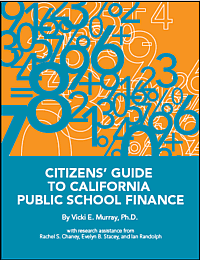In any given state, legislatures spend more on elementary and secondary education than any other major program, including healthcare, higher education, social services, and the criminal justice system. California is no exception. At $40 billion, K–12 education represents the largest share of the state general-fund budget. Yet few people comprehend how—or how much—funding public schools receive because of the complexity and murkiness of the California public-school finance system. To help remedy this lack of transparency, the Pacific Research Institute and Just for the Kids–California partnered to produce the California School Finance Center database, online at schoolfinancecenter.org

This database compiles publicly-available information on public school revenue, achievement, and student demographic data from a dozen California Department of Education sources to present the most complete picture possible of California public school funding so that parents, teachers, school board members, and policy makers can more readily access the information they need to make informed decisions about education policies affecting millions of school children each year. The goal is to provide a tool that helps school districts become more efficient in their quest to raise student academic achievement. The database provides:
- Total and per-pupil revenue for 973 public school districts, 286 charter schools filing distinct financial data, and 58 county offices of education
- Data on student achievement, demographic, census, and staff salaries for school years 2003-04 through 2007-08
- A Return on Investment feature that quantifies the relationship between a school district or charter school revenue, and its ability to increase student achievement.
- “Peer comparisons” where districts can connect to look-a-like districts that are getting more achievement from their resources to replicate best practices.
“California has the most expansive – and expensive – public elementary and secondary education system in the country. But because of the complexity of the school finance system, it’s difficult to understand if the money is being spent effectively to educate California students,” said Vicki E. Murray , Ph.D., associate director of Education Studies at the Pacific Research Institute. “Unlike any resource currently available, the database puts all funding for school districts and hundreds of charter schools, along with important student, staff, and achievement information, right at users’ fingertips.”
“For the first time, we have a tool to help us make a connection between resources and academic achievement,” said Jim Lanich, Ph.D., founder of the Just for the Kids-California and President of California Business for Education Excellence. “Just as we do in all of our work, this is about finding those that are outperforming expectations and then highlighting their practices for others to replicate. In these challenging economic times we want to shine a flashlight on those that are getting the job done for their students.”
Broad analysis of the data corroborates existing research that the current school finance system is irrational and inequitable. These findings include:
- State and local revenue for school districts enrolling smaller percentages of socio-economically disadvantaged students and English learners typically exceed revenue for school districts enrolling the highest percentages of these students.
- Higher revenue does not guarantee better student achievement. Average proficiency rates in English and math on the California Standards Test among the state’s highest-revenue districts are nearly indistinguishable from the lowest-revenue districts. In fact, more students in the lowest revenue districts are proficient in English and math then their peers in the highest revenue districts.
- From 2003-04 school year to the 2006-07 school year, total school district revenue increased in real, inflation-adjusted terms as student attendance essentially remained the same. Adjusted for inflation, total revenue increased just under 10 percent in 2006-2007 dollars. However, total average daily attendance during the same period decreased by more than 30,000 students or 0.5 percent.
The California School Finance Center database provides all revenue as reported by school districts, charter schools filing distinct financial reports, and county offices of education to the California Department of Education broken down into per-pupil amounts and presented in the finest level of detail currently possible according to existing revenue categories.
To access the California School Finance website, visit schoolfinancecenter.org.

